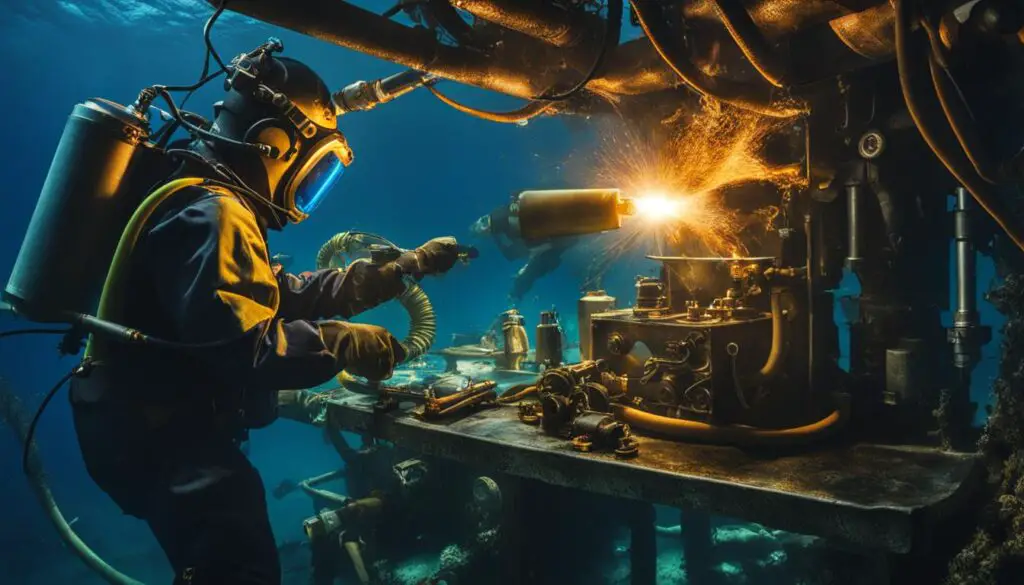Underwater welding is a fascinating and challenging profession that requires a unique set of skills and techniques. In this article, we will explore the world of underwater welding, delving into the intricacies of this high-risk job and uncovering the secrets behind the torch. Whether you’re an aspiring underwater welder or simply curious about this extraordinary trade, join me as we dive into the depths of underwater welding and uncover the skills and techniques that make it possible.
Key Takeaways:
- Underwater welding involves joining metal structures underwater, using specialized skills and techniques.
- There are two main methods of underwater welding: wet welding and dry welding.
- Divers must possess excellent diving skills and be proficient in using specialized diving equipment.
- Underwater welders must be skilled in various welding techniques and prioritize safety precautions.
- Despite the risks, underwater welding offers unique career opportunities and high earning potential.
Skills and Techniques of Underwater Welding
Underwater welding is a complex task that requires a combination of diving skills, welding techniques, and safety precautions. Let’s explore the essential elements that make underwater welding possible.
Diving Skills
Proficient diving skills are crucial for underwater welders to navigate the underwater environment effectively. These skills include:
- Handling underwater currents
- Maintaining proper buoyancy
- Operating diving equipment
Underwater welders must be well-versed in using diving masks, regulators, and the necessary underwater cutting and welding tools. These skills ensure their safety and enable them to perform their welding tasks efficiently.
Welding Techniques
Underwater welders must possess a diverse range of welding techniques to perform their work underwater. Some common techniques include:
- Shielded Metal Arc Welding (SMAW)
- Flux-Cored Arc Welding (FCAW)
- Gas Tungsten Arc Welding (GTAW)
Each technique has its advantages and is suitable for different underwater welding scenarios. Underwater welders must have a solid understanding of these techniques to choose the most appropriate one for the job at hand.
Safety Precautions
Ensuring safety is paramount in underwater welding due to the inherent risks involved. Underwater welders must take precautionary measures, such as:
- Proper insulation of electrical equipment to prevent electric shock
- Avoiding contact with hazardous marine life
These safety precautions minimize the likelihood of accidents and protect underwater welders from potential harm.

| Underwater Welding Equipment | Description |
|---|---|
| Diving Masks | Protect the diver’s eyes and nose while providing a clear field of vision. |
| Regulators | Control the flow of breathing gas from the scuba tank to the diver. |
| Underwater Cutting and Welding Tools | Specialized tools designed for underwater use, including torches, electrodes, and cutting equipment. |
Challenges and Rewards of Underwater Welding
Underwater welding is a career that comes with its fair share of challenges and risks. Divers conducting underwater welding face potential hazards such as electric shock, hypothermia, and decompression sickness. The unique work environment adds complexity to the job, including limited visibility, underwater currents, and the need to perform welding tasks in tight spaces.
Despite these risks, underwater welding offers a range of rewards. One of the major benefits of this profession is the opportunity to work in unique underwater environments, contributing to critical infrastructure projects such as offshore oil rigs and underwater pipelines. The demand for skilled underwater welders is high, making it a high-paying job with excellent career opportunities.
Working as an underwater welder provides the chance for divers to showcase their expertise in a specialized field. The underwater welding industry values professionals who have completed rigorous training and acquired the necessary qualifications. This lucrative career path allows divers to earn a substantial income while utilizing their welding skills in a truly extraordinary setting.
With the right training and dedication, individuals interested in underwater welding can embark on an exciting and fulfilling journey. It is a challenging yet rewarding profession that offers a unique work environment, high-paying opportunities, and a chance to contribute to vital infrastructure projects in the underwater realm.
FAQ
What is underwater welding?
Underwater welding is the process of joining metal structures underwater, using specialized skills and techniques.
What are the main methods of underwater welding?
The two main methods of underwater welding are wet welding, which is performed directly in the water, and dry welding, which is carried out in a hyperbaric welding habitat.
What skills are required for underwater welding?
Underwater welders need to have excellent diving skills, including the ability to handle underwater currents and maintain proper buoyancy. They also need to be proficient in using diving equipment and skilled in various welding techniques.
What are the risks of underwater welding?
Underwater welding presents significant risks, including potential hazards such as electric shock, hypothermia, and decompression sickness. Divers also face challenges such as limited visibility, underwater currents, and welding in tight spaces.
What are the rewards of underwater welding?
Despite the risks, underwater welding can be a highly rewarding career. It offers the opportunity to work in unique underwater environments, contribute to critical infrastructure projects, and earn a lucrative income. Skilled underwater welders are in high demand, with ample career opportunities available.
